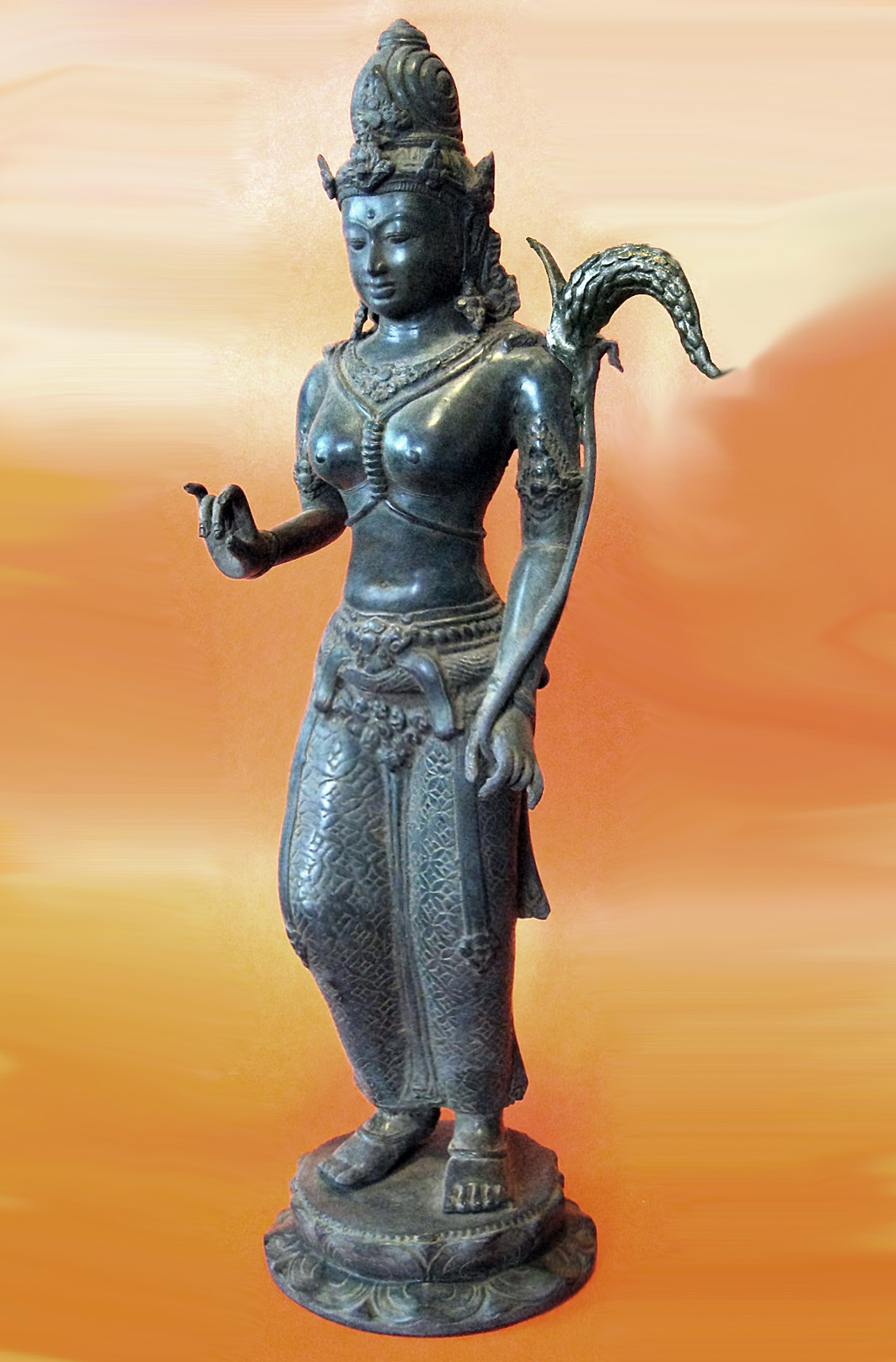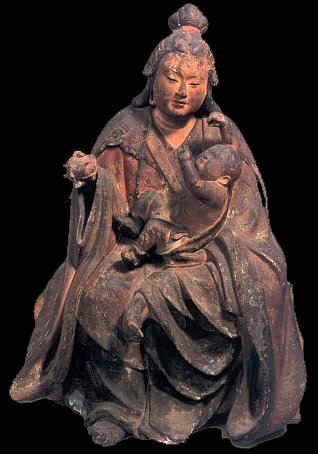Female Hindu and Buddhist Deity Images
It is sometimes difficult to determine whether some figurines are specifically Hindu, or ones that have been adopted by the Mahayana tradition, during the Shailendra and Majapahit periods; especially bearing in mind the syncretism, which took place between the two religions during many of the dynasties. The images below are female deities and are in no special order of importance. The numbered images are part of the Apsarah Gallery Collection.
Dewi Sri or Shridevi
 Material: bronze
Material: bronze
Patina: greenish brown
Posture: abhanga (standing on the left foot with the right leg bent at the knee) making the vitarkamudra (mudra of questioning) with the right hand and holding a sheaf of rice in the left hand.
Dewi Sri was worshipped as a goddess of rice and fertility before the Hindu period. After the adoption of Hinduism, the goddess was linked to the Hindu goddess Lakshmi, who is associated with wealth and family prosperity. Dewi Sri is still worshipped in Java and Bali.
1. Dewi Sri or Shridevi
 Material: bronze
Material: bronze
Patina: greenish brown
Posture: ardhapadma (half-lotus posture) with varadamudra (mudra of granting boons) with the left hand and holding a sheaf of rice in the left hand.
Dewi Sri was worshipped as a goddess of rice and fertility before the Hindu period. After the adoption of Hinduism, the goddess was associated with the Hindu goddess Lakshmi, who is also associated with prosperity. Dewi Sri is still worshipped in Java and Bali.
2. Dewi Sri or Shridevi
 Material: bronze
Material: bronze
Patina: greenish brown
Posture: ardhapadma (half-lotus posture) with varadamudra (mudra of granting boons) with the left hand and holding a sheaf of rice in the left hand.
Dewi Sri was worshipped as a goddess of rice and fertility before the Hindu period. After the adoption of Hinduism, the goddess was associated with the Hindu goddess Lakshmi, who is also associated with prosperity. Dewi Sri is still worshipped in Java and Bali.
3. Dewi Sri or Shridevi
 Material: bronze
Material: bronze
Patina: dark brown
Posture: ardhapadma (half-lotus posture) with vitarkamudra (mudra of questioning) with the left hand and holding a sheaf of rice in the right hand.
Dewi Sri was worshipped as a goddess of rice and fertility before the Hindu period. After the adoption of Hinduism, the goddess was associated with the Hindu goddess Lakshmi, who is also associated with prosperity. Dewi Sri is still worshipped in Java and Bali.
4. Sarasvati
 Material: bronze
Material: bronze
Patina: brownish green
Posture: sampada (standing with feet together).
Attribute: vina stringed instrument.
Sarasvati is the Hindu goddess of knowledge, music, arts and science and is the consort of Brahma.
Sarasvati is also a guardian deity in Buddhism, who upholds the teachings of the Buddha by offering protection and assistance to his followers.
5. Hariti
 Material: bronze
Material: bronze
Patina: brownish green
Posture: sampada (standing with feet together) holding a baby
Hariti was originally a Bactrian ogress who ate children and was said to have been converted to Buddhism by the Buddha and became the protector of children. The legend spread with Mahayana Buddhism to South-east and Eastern Asia including China, although the Chinese preferred Sung-tse q.v., a particular manifestation of Guanshiyin, the female manifestation of Avalokiteshvara.
In Japan Hariti is transliterated as Kareiti, but has other names depending on the sect.
6. Hariti
 Material: bronze
Material: bronze
Patina: brownish green
Posture: sampada (standing with feet together) holding a baby
Hariti was originally a Bactrian ogress who ate children and was said to have been converted to Buddhism by the Buddha and became the protector of children. The legend spread with Mahayana Buddhism to South-east and Eastern Asia including China, although the Chinese preferred Sung-tse q.v., a particular manifestation of Guanshiyin, the female manifestation of Avalokiteshvara.
In Japan Hariti is transliterated as Kareiti, but has other names depending on the sect.
Goddess Kariteimo
 Material: wood
Material: wood
Posture: seated, holding a baby with her left arm and a pomegranate in her left hand.
Hariti is transliterated in to Japanese as Kareiti and has different names depending on the Buddhist sect.
One name is 鬼子母神 Kisimojin, perhaps translating as Mother Goddess of Children.
7. Goddess Sung-tse
 Material: bronze
Material: bronze
Patina: very dark brown
Posture: sampada (standing with feet together), on a lotus pedestal, with the right hand holding a pustaka (holy book) and the left arm holding a baby.
Sung-tse may be compared to the Indian godess Hariti who was brought into Buddhism in India as a protector of children. In China, Hariti was not accepted, probably because of the prior existence of the Chinese goddess Miao Chen, who was already considered a female manifestation of Avalokitesvara. Thus Hariti was subsumed and became Sung-tse, a particular manifestation of Guānshìyīn or Guānyīn and in Chinese is called 送子娘娘 Songzi Niangniang, literally: send child goddess, or the Goddess Sender of Children. Many references spell the name Sung-tse, which is closer to the English pronunciation and usually translated as the Giver of Sons.